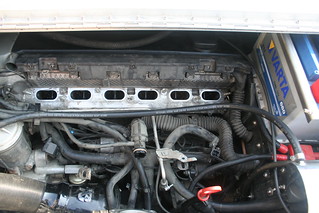When I bought my Cabrio kit, Marlin had only built one demonstrator using the BMW M50 engine, and sold one kit to a builder. In order to fit the engine width in the engine bay they had both cut 3" out of the width of the entire inlet manifold, requiring 6 individual inlet tubes to be cut, sleeved and joined. So, although I was nervous about doing it, I accepted the perceived wisdom of the time, and did the same.
Inlet manifold Cut and Sleeved

Although I felt I had made a good job of the modification, I always had a niggling doubt that this could prove to be its Achilles Heal - making the engine unreliable sometime down the road.
Several years later Jeremy created a solution to the issue in his Sportster by fitting the intake boot back to front, trimming it down where it fits to the throttle body, and facing the boot back towards the bulkhead. Very simple, very cheap, and the two ports molded into the elbow (to the ICV and sump) both faced downwards - perfect.
I began to wonder if the same might be possible in a Cabrio?
Initially I assumed the Sportster engine bay was bigger than a Cabrio - I always felt it looked wider.
But, never make assumptions................!
Over time, talking to Danny Nelson, and seeing other Sportster builders achieve the same solution I began to ask about Cabrio/Sportster similarities, and asked for comparative measurements. I have come to understand the original Ford based Sportster shared the same chassis as the Sierra based Cabrio, and though it has undergone bulkhead and rear end changes to accommodate different BMW donor rear subframes, the front chassis/engine bay still shares the same original Cabrio DNA.
So, maybe this meant I could use the same solution as the Sportster builders? It was an intriguing thought, but was going to involve some serious engine surgery just to even find out, so I held the thought until after IVA.
Well, this weekend I finally took the plunge. I had been prompted by a very small water leak under my bell housing, which I had traced back to somewhere under my inlet manifold, but was impossible to get at unless, and until, I removed the inlet manifold.
Another factor was that I was not happy with the cobbled up Smiths sender I had been obliged to fit to make my standard Smiths Water Temperature guage work, as it was too short and didn't extend deep enough into the waterway.
So, with three jobs to do, off came the inlet manifold!

Once removed the culprit for the water leak was soon located (the rear head water port)

At the back of the head is the port which feeds the internal heater, and the rubber pipe had not sealed properly despite the jubilee clip being tight.
This was easily resolved by fitting a smaller diameter piece of rubber hose.
Whilst the manifold was removed I changed the water temperature sender back to to the original BMW VDO sender: this will have to be connected to a new Smiths Classic VDO based guage.

It's the sender on the right of the two - the blue one on the left is the engine management temperature sender which feeds into the ECU.
I had to buy a new Smiths VDO guage to match the BMW VDO sender, so there is a knock on to all this which means the dash will have to come out again to replace the water temperature guage: oh the joys of kit car building!!
Once these two minor jobs were done, the moment of truth had arrived - could I fit a full width inlet manifold and keep it all within the width of my engine bay?

............and the answer is, Yes........... JUST!
By fitting the inlet elbow back to front, and trimming it down to the bare minimum where it fits the throttle body, it just fits. This is exactly how it had worked out in the Sportsters - very very cosy, but just possible.
I am delighted, as this means I can now run my engine normally with a standard inlet manifold.
One of the things I am hoping for is that the torque curve will be shifted back down the rev range a little with the longer inlet runners: only time will tell?
(I do have two other changes in mind which will have an impact on the torque curve of my Cabrio, but they will be have to wait).
I didn't get a chance to put all my pipe connections back on this evening so have not had the chance to run my engine yet - I'm looking forward to that almost as much as the first start, as this will hopefully be the final engine configuration for this year, and will give me a lot more peace of mind.